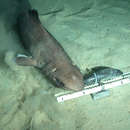Diagnostic Description
provided by FAO species catalogs
fieldmarks: No anal fin, two dorsal fins with large spines, bladelike unicuspidate teeth in upper and lower jaws, with lowers much larger than uppers, a moderately long and broad snout, fairly short first dorsal fin and high second dorsal, blocklike, very broad, sessile-crowned, wide-spaced, acuspidate lateral denticles, and rear tips of pectoral fins narrowly angular and strongly extended. Snout moderately long, broadly parabolic, preoral snout subequal or somewhat greater than mouth width but shorter than distance from mouth to pectoral origins; upper anterolateral teeth with erect to semioblique cusps. First dorsal fin moderately high and short, second dorsal moderately large, nearly as high as first, with base about 3/4 length of first dorsal base, and spine origin over inner margins of pelvic fins; distance from first dorsal insertion to origin of second dorsal spine about as long as tip of snout to pectoral insertions in adults and subadults; free rear tips of pectoral fins formed into narrow, angular and elongated lobes that reach well beyond the level of first dorsal spine, inner margins longer than distance from second dorsal spine to caudal origin; caudal fin with a shallowly notched posterior margin in adults and subadults. Lateral trunk denticles not overlapping each other, blocklike, with crowns sessile on bases and without pedicels, crowns broad and transversely rhomboidal in adults, without cusps on their posterior edges.
- bibliographic citation
- FAO species catalogue Vol.4. Sharks of the world. An Annotated and Illustrated Catalogue of Shark Species Known to Date Part 1 - Hexanchiformes to Lamniformes. Compagno, L.J.V.1984FAO Fisheries Synopsis. , (125) Vol.4, Part 1.
- author
- Food and Agriculture Organization of the UN
Distribution
provided by FAO species catalogs
Western North Atlantic: Northern Gulf of Mexico. Eastern Atlantic: France, Portugal, Madeira to Mediterranean, Canaries, Senegal, Ivory Coast, Nigeria, Cameroon to Zaire. Western Indian Ocean: Aldabra Island. Western Pacific: Japan (southeastern Honshu).
- bibliographic citation
- FAO species catalogue Vol.4. Sharks of the world. An Annotated and Illustrated Catalogue of Shark Species Known to Date Part 1 - Hexanchiformes to Lamniformes. Compagno, L.J.V.1984FAO Fisheries Synopsis. , (125) Vol.4, Part 1.
- author
- Food and Agriculture Organization of the UN
Size
provided by FAO species catalogs
Maximum total length at least 150 cm, young are born from 30 to 42 cm or more.
- bibliographic citation
- FAO species catalogue Vol.4. Sharks of the world. An Annotated and Illustrated Catalogue of Shark Species Known to Date Part 1 - Hexanchiformes to Lamniformes. Compagno, L.J.V.1984FAO Fisheries Synopsis. , (125) Vol.4, Part 1.
- author
- Food and Agriculture Organization of the UN
Brief Summary
provided by FAO species catalogs
A large fairly common deepwater dogfish of the outer continental shelves and upper slopes,usually on or near the bottom at depths from 100 to 1200 m, but commonest below 200 m. Ovoviviparous. Eats hake, epigonids and lanternfish.
- bibliographic citation
- FAO species catalogue Vol.4. Sharks of the world. An Annotated and Illustrated Catalogue of Shark Species Known to Date Part 1 - Hexanchiformes to Lamniformes. Compagno, L.J.V.1984FAO Fisheries Synopsis. , (125) Vol.4, Part 1.
- author
- Food and Agriculture Organization of the UN
Benefits
provided by FAO species catalogs
Primarily fished in the eastern Atlantic with bottom trawls, but also caught on hooks and lines and with pelagic trawls. Smoked and dried salted for human consumption; also processed for fishmeal and liver oil. Potentially valuable for its large liver, with high squalene content in the liver oil. The Japanese representative of the species is fished for liver oil.
- bibliographic citation
- FAO species catalogue Vol.4. Sharks of the world. An Annotated and Illustrated Catalogue of Shark Species Known to Date Part 1 - Hexanchiformes to Lamniformes. Compagno, L.J.V.1984FAO Fisheries Synopsis. , (125) Vol.4, Part 1.
- author
- Food and Agriculture Organization of the UN

